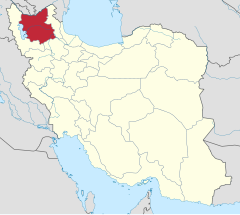Azerbejdżan Wschodni
| ostan | |
 | |
| Państwo | |
|---|---|
| Siedziba | |
| Powierzchnia | 45 650,5 km²[1] |
| Populacja (2011) • liczba ludności |
|
| • gęstość | 82 os./km² |
| Plan Azerbejdżanu Wschodniego | |
 | |
Położenie na mapie Iranu | |
Azerbejdżan Wschodni (per. استان آذربایجان شرقی, az. شرقی آذربایجان اوستانی) – ostan w północno-zachodnim Iranie. Stolicą jest Tabriz.
Geografia
Azerbejdżan Wschodni położony jest w północno-zachodnim Iranie w obrębie trzeciego regionu administracyjnego[2]. Od wschodu graniczy z Ardabilem, od południowego wschodu z Zandżanem, od południowego zachodu i zachodu z Azerbejdżanem Zachodnim, a od północy z armeńskim Sjunikiem oraz Azerbejdżanem, w tym Nachiczewańską Republiką Autonomiczną[3]. Zajmuje powierzchnię 45 650,5 km²[1]. Część zachodniej granicy ostanu stanowi brzeg jeziora Urmia[3], będący najniżej położonym miejscem w Azerbejdżanie Wschodnim (wysokość 1220 m n.p.m.). Najwyższym szczytem ostanu jest Kuh-e Sahand o wysokości 3772 m n.p.m.[4]
Klimat Azerbejdżanu Wschodniego jest suchy i chłodny, przy czym rejony górskie są bardzo zimne, a te nisko położone mają aurę umiarkowaną. Średnia najniższa roczna temperatura dla ostanu wynosi -1 °C, natomiast średnia temperatura stolicy wynosi 8,9 °C[4].
Do większych miejscowości położonych na terenie tego ostanu należą: stołeczny Tabriz, Maraghe, Marand, Ahar, Mijane, Sarab, Warzaghan, Azarszahr, Bonab, Malekan, Kalejbar, Adżabszir, Hasztrud, Szarafchane, Szabestar, Heris i Hadiszahr[3].
Wsie: Aghmijun.
Demografia
Według danych z 1991 roku Azerbejdżan Wschodni liczył blisko 3 278 000 mieszkańców, z których 55,1% zamieszkiwało miasta, a pozostałe 44,9% stanowili wieśniacy i ludy wędrowne[4]. Według spisu ludności z 2006 roku mieszkańców było 3 603 456. Spis ludności z 2011 roku podaje 3 724 620 mieszkańców, co stanowiło 4,96% populacji Iranu. Wśród tych osób 1 882 031 stanowili mężczyźni, a 1 842 589 kobiety. 70,7% stanowiła ludność w wieku 15-64 lat, 22,2% w wieku do lat 14, a 7,1% w wieku lat 65 i starsi[1].
Przypisy
- ↑ a b c Statistical Center of Iran: National Population and Housing Census 2011 (1390): Selected Findings (ang.). The President’s Office Deputy of Strategic Planning and Control. [dostęp 2014-10-23].
- ↑ همشهری آنلاین-استانهای کشور به ۵ منطقه تقسیم شدند (Provinces were divided into 5 regions). „Hamshahri Online”, 2014-06-22 (1 Tir 1393, Jalaali). ISSN 1735-6393 (pers.). [zarchiwizowane z adresu 23-06-2014].
- ↑ a b c Eastern Azarbaijan Province. W: Google Maps [on-line]. [dostęp 2014-10-23].
- ↑ a b c Eastern Azarbaijan. Geography and History. ISTA Inc.. [dostęp 2014-10-23]. [zarchiwizowane z tego adresu (11-04-2014)].
Media użyte na tej stronie
State emblem of the Islamic Republic of Iran. U+262B, stylized version of Arabic script of Allah (الله, with the central lam shaped to look like a sword.) The emblem is also an overlaid rendering of La Ilaha Illa Allah (There is only one God and that is 'Allah'). The exact shape of the emblem and an algorithmic ruler-and-compass construction is described in the national Iranian standard at IRANIAN ISLAMIC REPUBLIC FLAG, ISIRI 1, 1371, 3rd edition, March 1993 in Persian. The emblem was designed by Hamid Nadimi, and was officially approved by Ayatollah Khomeini on May 9, 1980.
Autor: Abdossamad Talebpour, Licencja: CC BY-SA 3.0
The photo presents the scenic landscape from Hejran Dust village.




